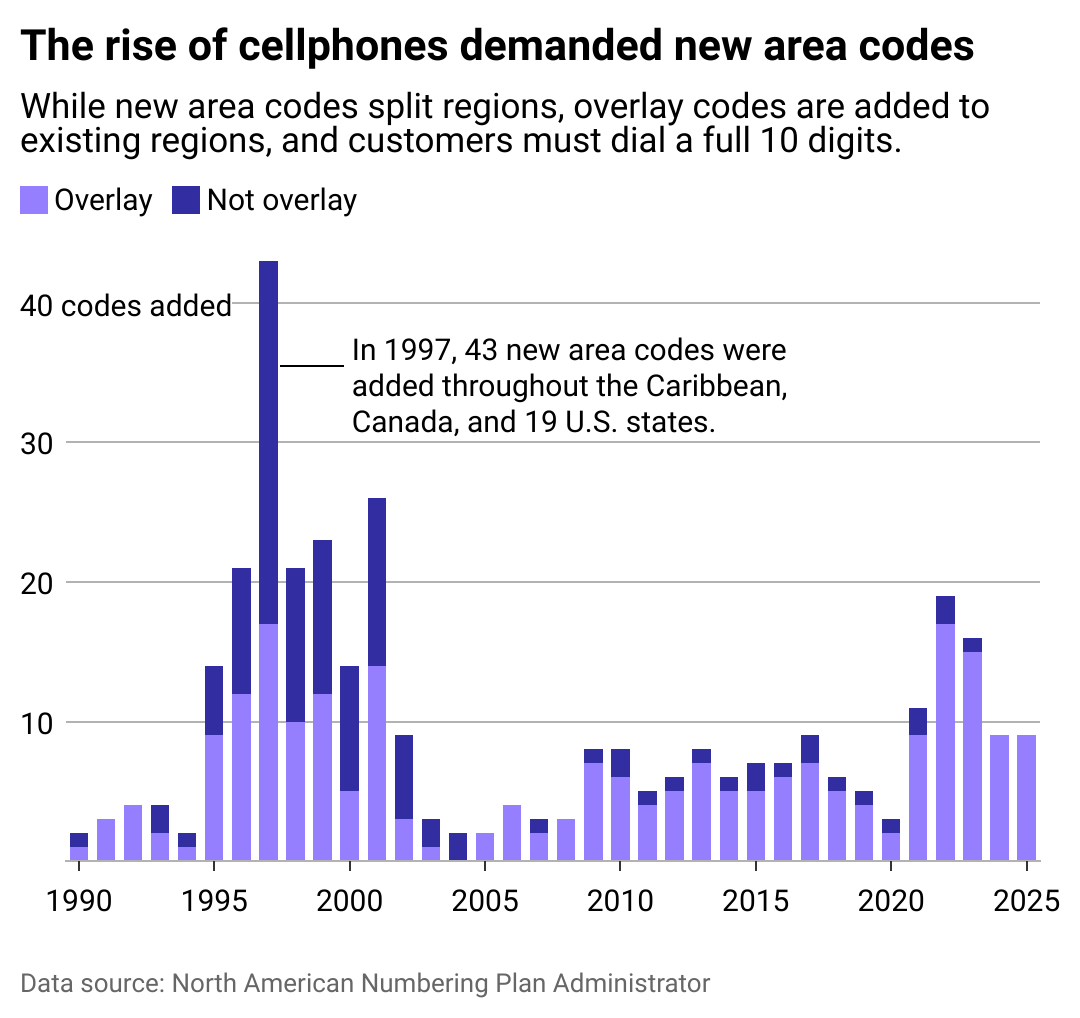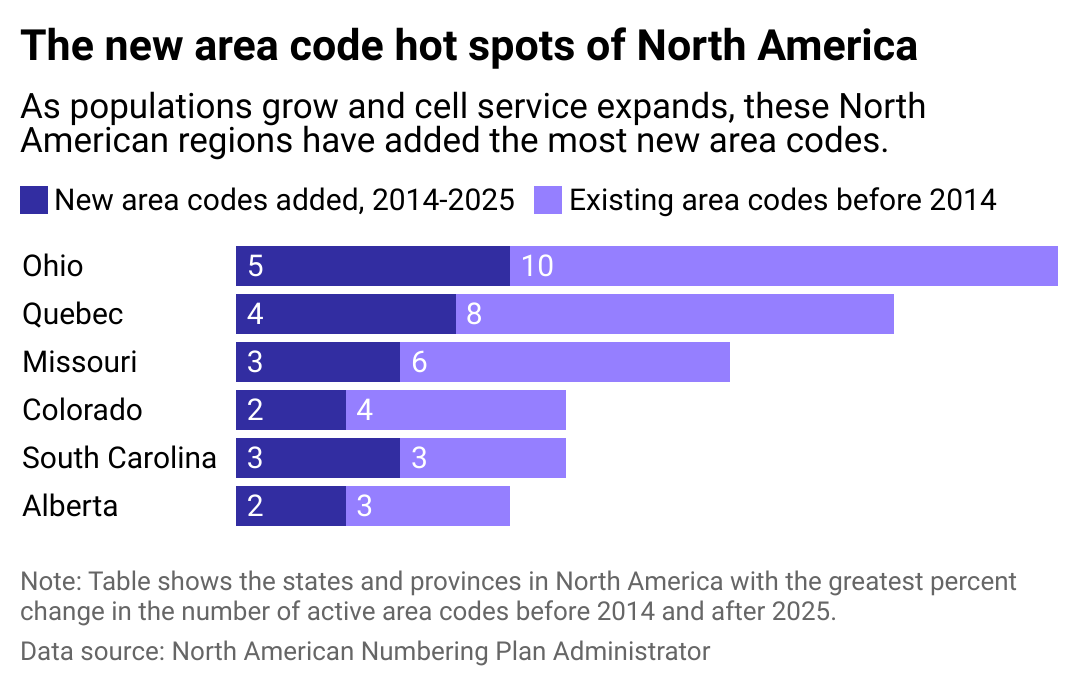Wind: mph,
Welcome to our new web site!
To give our readers a chance to experience all that our new website has to offer, we have made all content freely avaiable, through October 1, 2018.
During this time, print and digital subscribers will not need to log in to view our stories or e-editions.

212. 213. 312. If you know, you know.
Over nearly 80 years, area codes have come to signify regional identities and a deep connection to a place. So what happens when tech and population growth collide, and the three-digit number synonymous with home is no longer available?
Spokeo analyzed the proliferation of area codes and how they are assigned to people using information from the North American Numbering Plan Administrator, illustrating how some regions might be undergoing a change in which codes are the coolest.
Area codes have taken on a life of their own. Consider the 212 area code in Manhattan, for instance. New Yorkers have bestowed it with a certain status; there's even a phone brokerage company that sells 212 numbers. When new area codes were introduced in Manhattan, some residents weren't pleased—including Elaine Benes on "Seinfeld," who spent the whole Season 9 episode "The Maid" trying to get her coveted 212 area code back after being assigned a new 646 number.
Yes, even pop culture acknowledges the prestige of 212, but area codes didn't start as status symbols. In the 1940s, when phone operators connected calls, the Bell Telephone Company created a new system allowing people to make direct calls to whomever they wanted—no operators involved. As phone numbers outnumbered the human operators who could connect calls, the change was a natural evolution.
Enter the area code. These three-digit numbers became part of the North American Numbering Plan. Eighty-six distinct Numbering Plan Areas were created, with most states getting one area code by 1947; high-population states had more. The Bell System used a distinctive structure based on population size rather than geography to assign area codes.
States with more than one area code were given the number "1" as a second digit, while those with only one were given the number "0" as a second digit. Because rotary telephones require longer rotations to enter "0" and other small numbers, the digits mattered. The most populated regions, such as California, were assigned the area codes that were the least cumbersome to dial.
Over time, population growth and an increase in telephone devices created overlay codes. When the original code numbers are exhausted, these secondary area codes are assigned to serve the same geographic region as another existing area code, which brings us back to 212.
"You feel like it's New York, as trivial as that sounds. It's sort of an icon of New York to have the 212 area code, like Broadway or yellow cabs," Nan Kim, then a graduate student at Columbia University, told The New York Times in 1999.
But there wasn't much a new New Yorker could do. After 45 years, the 212 numbers were close to being exhausted. In 1992, 917 hit the town, specifically for cellphones and pagers; the 646 area code was introduced in 1999, and in 2017, Manhattan received a new 332 area code. Now there are at least seven area codes in the area (one original, six overlay).
Many regions have followed similar patterns. In March 2024, a new 436 area code was designated for Ohio alongside the existing 440 code. This August, Minnesota will welcome a new 924 area code alongside the existing 507 code. Although overlay area codes fill the need for more phone numbers, users may still feel a void: losing regional identity.

In the 1990s, between the rise of cellphones and a relatively transient period for Americans, area codes changed to indicate not only where you were but where you'd been. They became geographic wanderers—is someone with a 310 number really calling from Los Angeles? Who knows.
Landlines, modems, fax machines, and pagers remained prominent while cellphones proliferated. According to Atlas Obscura, as tech evolved, there were more devices and people with phones than permutations for a single area code. A December 2000 Federal Trade Commission report estimated around 4.4 million cellphone subscriptions in June 1990; a decade later, that figure grew to 97 million subscriptions in June 2000.
Cellphones have since become a regular aspect of daily life. In the past, one residence might have one landline phone; now, every person in the same household may own their own cellphone, necessitating more phone numbers.
As the number of phones mushroomed, more people had phone numbers in concentrated areas— growth that allowed area codes to represent more specific geographics and communities. That's particularly true in high-growth areas like California. In the San Gabriel Valley outside of Los Angeles, for instance, the 626 Nightmarket pays homage to late-night open-air bazaars common in Asia, using the area code to suggest the iconic nature of the event. In the Valley's Chinese enclave, it's not only a marker of place but also of community and local identity.
The influence of using area codes to express hometown pride and local identity can be largely attributed to hip-hop culture. Songs like Azealia Banks' "212" and Pitbull's "305 Anthem" have made area codes a kind of shorthand among fans expressing loyalty to an artist and their community. Most recently, rising rapper Kaliii's "Area Codes" hit the Billboard charts, driven in part by TikTok.
On the flip side, area codes inextricably linked with a particular community or enclave also lend themselves to stereotypes. The Los Angeles 310 area code was pegged "the enviably rich, and the plastic surgeons who enable them," according to The Los Angeles Times.

Currently, there are 359 area codes active in the United States and Washington D.C. Moreover, there are 7,919,900 possible combinations of numbers for each one of these codes—and those numbers are growing.
In summer 2024, South Carolina will receive a new 821 area code alongside the existing 864 area code, bringing the total number of area codes in the state to six. Colorado will welcome a new 748 area code in 2026 alongside the existing 970 one. It will cover several cities—including Aspen, Sterling, and Steamboat Springs—along with others. When the new code is implemented, Colorado will have six area codes active.
As more area codes are added, perhaps the newer ones will become markers of dynamic, exciting, and vibrant areas of growth.
Story editing by Alizah Salario. Additional editing by Kelly Glass. Copy editing by Paris Close. Photo selection by Ania Antecka.
This story originally appeared on Spokeo and was produced and distributed in partnership with Stacker Studio.